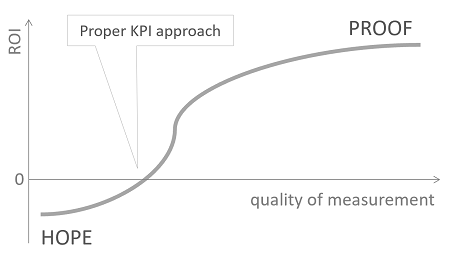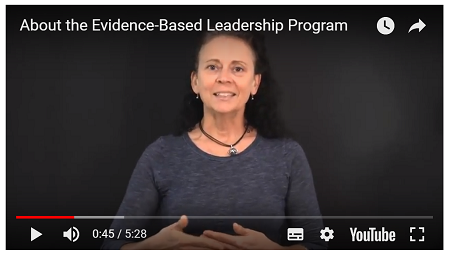The Formula to Win Leadership Support for Better KPIs
by Stacey Barr |Before you start a new performance measurement approach, first use this formula for the right conversation to win leadership support for better KPIs.

As a specialist in performance measurement, KPIs and evidence-based leadership, my work is to sell and help people implement my ideas. The implementation has always been the easy part for me. The selling has always been the struggle.
A few years ago I came across a method that made a huge difference in my comfort, confidence and success in selling the idea of better performance measurement. It’s called the Green Sheet, and it is a conversation guide developed by thought leadership expert, Matt Church. (I learned about it through his Thought Leaders Business School, but there is a bit about the Green Sheet in his great book, The Thought Leaders Practice).
There are three main reasons why I think the Green Sheet conversation has helped me to sell the idea of better performance measurement:
- It starts with their struggles, not our solution. No one will ever find a solution relevant unless it’s linked to their struggles.
- It flows naturally in conversation, and sets a logical sequence in which to place our solution.
- It speaks to both the left and right brain. It engages people with fact and feeling as we invite them to consider our solution.
If you struggle to get leadership support for better KPIs, you’re not alone. It’s the single biggest reason why my clients (PuMP users) don’t make the progress they hoped for. Even leaders have leaders they want to influence!
So I have written lots already about influencing leaders to support KPIs. But what follows is more detailed and specific guideline for having the best kind of conversation you can to win leadership support for better KPIs.
Believe that you *can* influence leadership beliefs about performance measurement.
It’s hard to approach people in a more senior role. We worry about wasting their already stretched time. We worry about looking like an idiot. We worry they will completely ignore us. But with more understanding and preparation, we can get more confidence and belief.
Before you start with the formula I’ll give you, it’s wise to research a bit about how your leaders likely feel about performance measurement. I suggest the following:
- understand why leadership support is so critical for creating a performance culture
- appreciate that leaders fear KPIs and performance measurement, just like anyone
- assess which measurement-related mindset shifts you might want to influence in your leaders
- focus on the reasons that leaders do support better measurement
- prepare for the likely objections leaders will have against adopting a better performance measurement approach
Here is how I use the Green Sheet as a formula to guide the right conversation to win leadership support for better KPIs:
Step 1: Start by agreeing on the outcome of better KPIs.
In the Green Sheet process, there are two value statements. A value statement will describe the outcome we want to help our leaders achieve, as a result of better KPIs.
The first of the two value statements is the left brain version, which is a measurable or countable expression of the outcome. One of the left brain value statements I often use to sell the idea of better performance measurement is this:
“More goals are achieved, sooner and with less effort.”
The second of the two value statement is the right brain version, which is a more visceral, rather than measurable, expression of the outcome. Here’s one of the right brain value statements I often use:
“More people are excited and compelled to contribute to executing strategy and improving performance.”
Step 2: Acknowledge their struggles to achieve that outcome.
This idea of understanding people’s struggles before offering a solution has been dear to my heart for decades. It’s how PuMP was designed and evolved – to directly deal with the most common struggles people have with KPIs and performance measurement.
From my experience, it’s likely your leaders have these big struggles:
- Strategy is really hard to measure meaningfully, especially the intangible goals that matter most.
- Communicating strategy in a way that really excites people and triggers their engagement is quite tough and rarely works.
- Strategy isn’t executed, targets aren’t achieved, and people just don’t seem to take ownership for contributing to the organisation’s goals.
Of course, use these as prompts in your conversation to win leadership support for better KPIs. But absolutely make it an exploration by inviting them to build on those.
Step 3: Describe the journey from their struggles now, to the outcome they want.
Notice how we didn’t start this conversation to win our leader’s support with the solution? We’re not ready even yet to share our solution. We need to make visible the pathway from where they are now to where they want to be.
In the Green Sheet, this is called the value model. One of value models that I like to use, to describe that pathway, is an s-curve. The s-curve starts at having only hope that strategy will be executed and goals achieved. And it ends at proof that strategy is executed well and goals are achieved. The tipping point is the introduction of a proper KPI approach. And with more and more quality in measurement across the organisation, the ROI of strategy execution just gets better.

You can use any kind of model to describe the pathway from your leader’s struggles to the outcome they want. It just has to make sense and relate to the value statements and struggles you discuss earlier in the conversation.
Step 4: Share your solution!
The first three steps of this guide to win leadership support for better KPIs have set the context. Your conversation with the leader so far will have shown respect for their situation, for their struggles to get what they need. And now they are more likely to feel open to hearing your ideas.
The idea I want to position at this point is usually the adoption of a deliberate performance measurement methodology, namely PuMP. So I share a framework of bad KPI habits that cause those struggles they have already expressed. And I show the alternative practice to each of those bad habits, that end the struggles. The collection of alternative practices is PuMP.
Step 5: Come back to the value (the outcome).
In a way, you’re closing the circle at this point, by relating your solution back to the outcome your leader wants. That outcome is from Step 1 above, the value statements.
Check if your leader sees the connection now, between your solution and the pathway to the outcome they want.
Step 6: Wrap up with a metaphor.
A metaphor is a great way to sum up the message you wanted to make in a nutshell. Metaphors are succinct, familiar and easy to remember.
For measurement, I like the metaphor of measurement as leverage. As Archimedes’ is often quoted: with a lever long enough, and fulcrum on which to place it, one could move the world. The lever is our strategy. The world is the organisation’s purpose. The fulcrum is measurement.
Step 7: Ask for their decision.
What decision should your leader make now? Be specific about what you want to ask of them. Don’t be vague and don’t leave it up to them. Prepare yourself with the specific action you want them to commit to. It could be one of these examples:
- Agree to a PuMP Pilot, where a team tests the methodology to measure and achieve a single goal.
- Hold an in-house PuMP Blueprint workshop to train all the strategy and reporting people in good measurement techniques.
- Schedule an Evidence-Based Leadership workshop for the executive team to learn how to lead and support better measurement practice.
What action do you want your leader to say either ‘yes’ or ‘no’ to?
Watch a video where I use this formula to sell the idea of evidence-based leadership.
Remember this is a guideline only. You’ll want to be organic and authentic in how you hold this conversation. And you might need some practice too! To give you a real example, I have a video of me using this formula to sell the idea of evidence-based leadership.
You can see it here, as you watch it, notice when I’m talking about the different elements of the Green Sheet process, described above.
To win leadership support for better KPIs, start with their WHY to set the context for your HOW.
[tweet this]
DISCUSSION:
Do you have a leader or influencer that you want to invite to the idea that better KPIs? How would you outline your conversation with them?
Connect with Stacey
Haven’t found what you’re looking for? Want more information? Fill out the form below and I’ll get in touch with you as soon as possible.
167 Eagle Street,
Brisbane Qld 4000,
Australia
ACN: 129953635
Director: Stacey Barr





